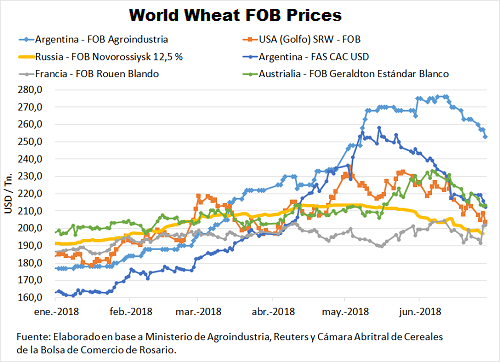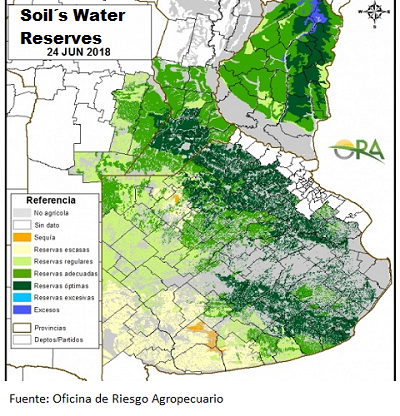The price of next harvest wheat keeps its downward path, generating lower volume of marketing
FEDERICO DI YENNO - FRANCO RAMSEYER
The price of next harvest wheat fell below U$S 180 / tn in MATba Wheat reference prices in the Rosario Board of Trade continued their bearish trend, measured in dollars, decreasing compared to the previous week in the spot segment. In dollars the price decreased from U$S 216 / t per day Thursday 21 to U$S 212.5 / t on Thursday 28.
In the same way as international prices, the FOB price of wheat (for the nearest delivery) in the ports of Argentina began to fall sharply at the beginning of June. In recent weeks, it is the fall in the international price of wheat that puts pressure on cereal prices. Other factors, such as international policy and financial issues, push the price of grain down (similar to what happens with corn and soybeans). The commercial conflict in the United States and China has strongly shaken the international financial and commodity markets. Furthermore, a global economy that grows at a slower pace, is a world that demands commodities at a lower rate. Similar effect was felt on the actions of the different stock exchanges worldwide. The FOB price of wheat for shipment to December in the Up River ports fell 8 USD / t from the beginning of June to June 27, reaching USD 198 / t, according to the FOB Officials prices reported by the Ministry of Agroindustry. The fall in the FOB price was transferred to the harvest price of the futures negotiated in MATba (Buenos Aires Futures Market) for wheat with delivery in Rosario to December 2018. The advance of the 2018/19 wheat sowing is optimal, giving a favorable framework to the production According to the latest weekly report of our institution's Strategic Guide for Agriculture (GEA), hectares could be added to the planting of wheat in the core region. This year, the region could end up incorporating 250 thousand hectares to the 1.1 million hectares of last year. The days without rain allow seeders to advance fluidly, exceeding 50% of the intentional area nationwide. Soil water reserves for cultivation range from moderately scarce (in the west of the country) to adequate and abundant in the east. Most of the lots pass the vegetative stages of emergence and foliar differentiation under very good to excellent conditions and without fungal problems.
According to GEA, the objective of obtaining high productivity wheat has been defined in the region. All the factors are optimized so that it is possible to reach a new productive ceiling. Producers are trying to foster yields, thus, fertilization will be even greater than last year. The crop has shown an excellent response, fertilizing 40 quintals, many ended up harvesting 60 quintals. Very productive genetics are being used, but also very susceptible to diseases. That is one of the weak spots of cultivation in the region. But the sanitary management is already approached from the beginning, another fundamental point that has changed in the new management that is made of the crop.

